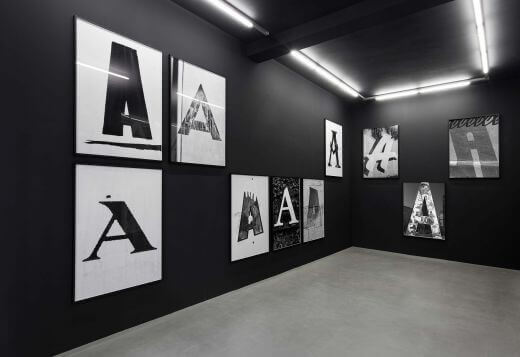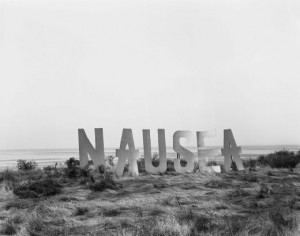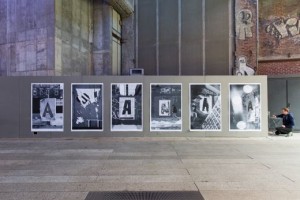Shannon Ebner’s Material Lexicon
Carmen Hermo

Shannon Ebner, Black Box Collision A, 2014. Chromogenic prints. Installation view: Black Box Collision A: Gasoline & Auto Electric, kaufmann repetto, Milan, May 22–August 8, 2014. Courtesy kaufmann repetto, Milan
The letter that inaugurates our Roman alphabet cries out, repeatedly, from the installation of Shannon Ebner’s Black Box Collision A. In this ongoing work begun in 2012, Ebner displays that familiar, yet mutable form, isolated from its adjacent letters and real-life context. Against the “black box” of the blackened gallery walls, undulating black-and-white captures of the letter A surround the viewer. The outsize scale of the photographs imposes a kind of surreality; though the letters seem the right size for advertisement-like legibility, they refute it, offering instead an alternating study of form and style. Some letters bear the excitable edge of handmade, come-hither commercialism, while others appear oddly ominous, with portentous volume and hard edges that, at times, extend nearly to the edge of the image. As is often seen in Ebner’s work, traces of construction and industry abound—some A’s appear to be borrowed from work site caution signs, while others are evidently extracted from graffiti tags. In making the work, Ebner ambled around Los Angeles, noticing and capturing these letters, ultimately presenting them together in a confluence of differences and similarities.
The striking effect of Black Box Collision A lies in its exchange with the viewer: the act of reading the letters as coherent words is ultimately futile, but the looking forms its own experiential reading. This transformation begins with Ebner’s dedication to black-and-white photography, a hallmark of her work. In a world subsumed with insistent and endless snapshots in living color, Ebner cools down the viewers’ intake of their environment. Photography necessarily flattens its subject, and monochrome or grisaille palettes throw images into contrast. Ebner’s photographs seem to engender a visual language, where spindly or full shapes lose their context and their definition, but become instead a topography of the scripts that surround us. Ebner appreciates what she terms the “indeterminacy” of the black-and-white photograph, a medium that risks connoting the documentarian, historical, or archival if applied without precision. Ebner skirts this hazard by using photography as a pointed tool to question the manifestation and meaning of language itself. By shooting the latent language that surrounds us, a nonlinear anti-narrative is constructed by accumulation. It’s that totality of intent that marks Ebner’s practice as ongoing, a concerted and unceasing study of the varied forms and functions of language, most often captured through the mediums of photography and sculpture.
If all of this seems obtuse and conceptual, consider the unabashed political undertones of the body of work that brought her to the attention of the art world: her Dead Democracy Letters series (2002–06). Developed as a response to the ongoing War on Terror—a conflict experienced in the United States through a strain of twisted rhetoric and euphemistic obfuscation of violence and torture—the work took the form of twenty-six wooden letters, positioned and photographed across the Californian landscape. The images morphed the graphic identity of the Hollywood sign into one-off snarls of discomfort and alienation, stark landscapes injected with evocative language: “NAUSEA,” or “LANDSCAPE INCARCERTION.” At the Whitney Biennial in 2008, the characters were displayed shuffled into a wooden crate, and labeled, in spray paint, “SCULPTURES INVOLUNTAIRES.” The tagged French title alludes to the beloved snapshots of Braissaï, whose surreptitious captures of Paris between the world wars inspired the Surrealists’ affections for the irrational beauty of the quotidian. Another historical reference often appended to Ebner’s practice is that of the Conceptual artists Bruce Nauman, Ed Ruscha, and Robert Smithson—artists who traced the intersections of language and the American landscape. Braissaï, these Conceptualists, and Ebner all eschew the documentary appeal of their medium, reaching through photography to examine and uncover the latent social and cultural meaning of their subjects.
In recent years, Ebner’s work has divested its direct response to world events, moved away from the landscape, and settled into something more poetic, even archeological. That’s evident in Black Box Collision A, which is presented in its first museum survey at the Institute of Contemporary Art, Miami (ICA), from October 8, 2015 through January 17, 2016. It will be the first major solo presentation of the artist’s work since installations at New York’s MoMA PS1 (2007) and simultaneous shows at the Hammer Museum and LAXART in Los Angeles (2011), where the artist lives and works.
The topography of that fair, sprawling city—with both faded and of-the-moment advertisements beckoning from billboards and city walls alike—is an undeniable influence on Ebner’s recent work. Still, biographical bits from her life before Los Angeles persist. Born in Englewood, New Jersey, in 1971, Ebner’s upbringing in the New York metropolitan area—where the industrial cleaves the residential and vice versa—exposed her to the odd poetry of the everyday. In 1993, she graduated from Bard College and moved to New York, where she was involved in the poetry scene associated with the (still extant) Poetry Project at St. Mark’s Church, working directly with Eileen Myles, who was mounting poetry workshops in artists’ studios at the time. Somewhere amid her poetry career, Ebner used a disposable camera to illustrate a particularly visual poem. The handheld, Xeroxed serial of words and images inspired her to return to photography exclusively. After she completed her MFA in photography at Yale University in 2000, she relocated to Los Angeles. There she began her artistic project: rather than use images as indexes of language and content, Ebner creates self-reflexive works that plumb the panoply of verbal, graphic, or audible utterances that comprise our society. The alphabet—literal, poetic, or constructed—became the modular subject of her practice.
Modularity and seriality allow for exploration of the salient themes of Ebner’s work. At ICA, Ebner will construct two new sculptures based on earlier sculptural manifestations of graphic symbols, sited specifically for Miami. The work (…), from 2010, depicts an ampersand made from cinder blocks and cement. The readymade materials, which are the basis of all urban construction projects, have been shaped to form the symbol (actually, the logogram) for the phrase “and per se and,” which over time became simply “and,” with a snippy and recognizable shape. This form-object acts as a mechanical joiner for language, uniting disparate words or ideas. The sculptural object forces the viewer to question what the object might be joining—two spaces, perhaps, or the meeting of viewer and sculpture, or the viewer and the space alone. There’s an openness shared among language, form, and execution. Using such basic materials, Ebner created what she terms an “anti-monument.” Modular by nature, Ebner also executed ampersand sculptures in Los Angeles and at the Venice Biennale (both in 2011). Sculptures enter and reside in space very differently than photography, allowing Ebner to explore locality in her practice.

Shannon Ebner, USA (2003), from Dead Democracy Letters (2002–06). Chromogenic print, 80 x 101.3 cm. Courtesy the artist
Photography can transcend that imposed physicality, and Black Box Collision A found an extrapolated, temporal footing in a project Ebner produced in collaboration with David Reinfurt for New York’s High Line Park. Photographs of singular A’s were wheat-pasted across the rapidly changing landscape of neighborhoods transforming into luxurious cultural enclaves, only to be taken down by passersby or the vagaries of the weather. Each image became autonomous from the series, but simultaneously contingent on its environment. Experienced individually against massive construction sites or ad campaigns, the black-and-white photographs appeared like last, graphic grasps at unique, hand-painted forms of language. The High Line project injected temporality and movement into a series that otherwise suppresses the actions of the artist in favor of the resulting material lexicon. Situating it within a site of tourist and art-world activity highlights the searching and movement behind the finality and solidity of each A.
Ebner’s practice is not concerned with finding poetry in the mundane forms of language, but rather in creating it, via photography, sculpture, and unique projects that often begin with poems but end in videos, installations, or even flashing highway signs. Auto Body Collision (2014) was exhibited at the Fondazione Memmo in Rome the year of its making. Amid the palatial galleries, Ebner set up precariously placed, six-foot-tall cardboard letters, physically constructing a poem between the galleries. The words appear to be borrowed from auto body shop signage: “CENTER,” “FIRST,” “CLASS AUTO,” often ruptured by a replacement of certain letters with symbols, like a forward slash and twelve-pointed asterisk. Interspersed among the concretized poem were small abstract forms in cardboard and sumptuous
black-and-white photography of crushed-up junkyard cars. The photographs carry the trace of destruction, following moments in which machines and human bodies collide. The word auto
also carries a decidedly un-automotive second meaning, as “self” in Greek. The collision of the self and the body is the subtext of the poem, which combines discarded and found language in odd, recombinant phrases. Unbound from the page—the usual ground for poetry—and paired with the black-and-white, nearly documentarian photographs of junkyards and graffiti street directions, the poem feels unfixed, undone, and dodges easy reading.
In our daily digital lives, reading is easy: scrolling, linking, opening new tabs. Photography is easy, too, as cameras are always at the ready to capture our selves, our bodies, and our surroundings in dozens of shots, until the right one is found. Surrounded by an over-saturation of images—and, truth be told, an over-saturated art world—Ebner’s focus is to provide her viewers with their own task, to read between the reading and truly think about the forms that comprise each image-poem. The simplicity of language itself is thwarted, uncovered for its undercurrents of construction, mediation, and experience.
Carmen Hermo is an assistant curator for the collection at the
Solomon R. Guggenheim Museum, New York.











